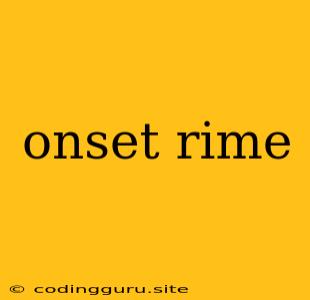Unlocking the Power of Onset and Rime: A Journey into Early Literacy
The world of language is a complex and fascinating one, especially for young learners. As they navigate the intricacies of reading and writing, they encounter a myriad of concepts that pave the way for successful literacy. One such crucial concept is the understanding of onset and rime, often referred to as onset-rime or phoneme segmentation. This concept forms the foundation of early phonics instruction, helping children decipher the sounds of words and ultimately, become confident readers.
What is Onset and Rime?
Simply put, onset and rime are the building blocks of syllables. Onset refers to the initial consonant sound or sounds of a syllable. Rime is the remaining part of the syllable, which includes the vowel sound and any following consonants.
Example:
Let's take the word cat.
- Onset: "c"
- Rime: "at"
Why is Understanding Onset and Rime Important?
The importance of understanding onset and rime for early literacy development cannot be overstated. Here are some key reasons:
- Decoding Skills: Children who can segment words into onset and rime are better able to decode unfamiliar words. For instance, if a child knows the rime "at" in the word "cat", they can apply this knowledge to other words with the same rime, such as "hat", "mat", "sat", etc. This fosters a sense of predictability and reduces the cognitive load required for reading.
- Phonics Awareness: Understanding onset and rime strengthens a child's understanding of phonics, the relationship between letters and sounds. They can see how different onset sounds can be combined with the same rime to create new words, reinforcing the concept of letter-sound correspondence.
- Spelling Skills: Onset and rime are equally important for spelling. By breaking down words into their component parts, children can more easily identify and spell the different sounds within a word.
- Word Families: Recognizing onset and rime helps children identify word families, which are groups of words that share the same rime. This allows them to make connections between words and expand their vocabulary.
Teaching Onset and Rime to Children
There are various engaging and playful ways to teach children onset and rime:
- Manipulatives: Use objects like blocks or counters to represent the onset and rime of a word. For example, place three blocks to represent the onset "c" in the word "cat" and two blocks to represent the rime "at".
- Games and Activities: Play games like "Rime Match" where children match pictures of words with the same rime. Use clapping or tapping to segment the onset and rime of a word.
- Rhyming Books and Poems: Introduce rhyming books and poems, as they naturally highlight the similarities and differences in the rimes of words.
- Songs and Finger Plays: Incorporate songs and finger plays that focus on onset and rime segmentation.
Tips for Parents and Educators
- Start Early: Introduce onset and rime concepts at an early age, even before formal reading instruction begins.
- Make it Fun: Use a variety of engaging activities and games to make learning onset and rime enjoyable.
- Focus on Meaning: While it's important to teach the mechanics of onset and rime, don't forget the importance of connecting these concepts to real words and their meanings.
- Be Patient and Consistent: Learning onset and rime takes time and practice. Encourage children to experiment, make mistakes, and learn from their experiences.
Examples of Onset and Rime in Action
- "The Cat in the Hat" by Dr. Seuss: This classic children's book features numerous rhyming words that help children grasp the concept of rime.
- "Chicka Chicka Boom Boom" by Bill Martin Jr. and John Archambault: This book uses alphabet letters that rhyme, reinforcing the rime concept.
- "Brown Bear, Brown Bear, What Do You See?" by Bill Martin Jr. and Eric Carle: The repetition of the phrase "Brown bear, brown bear, what do you see?" allows children to hear the rimes in the animal names.
Conclusion
Understanding onset and rime is a crucial stepping stone for developing strong reading and spelling skills in young children. By incorporating playful activities and engaging strategies, we can help children build a solid foundation in phonics and pave the way for a love of reading and writing.
